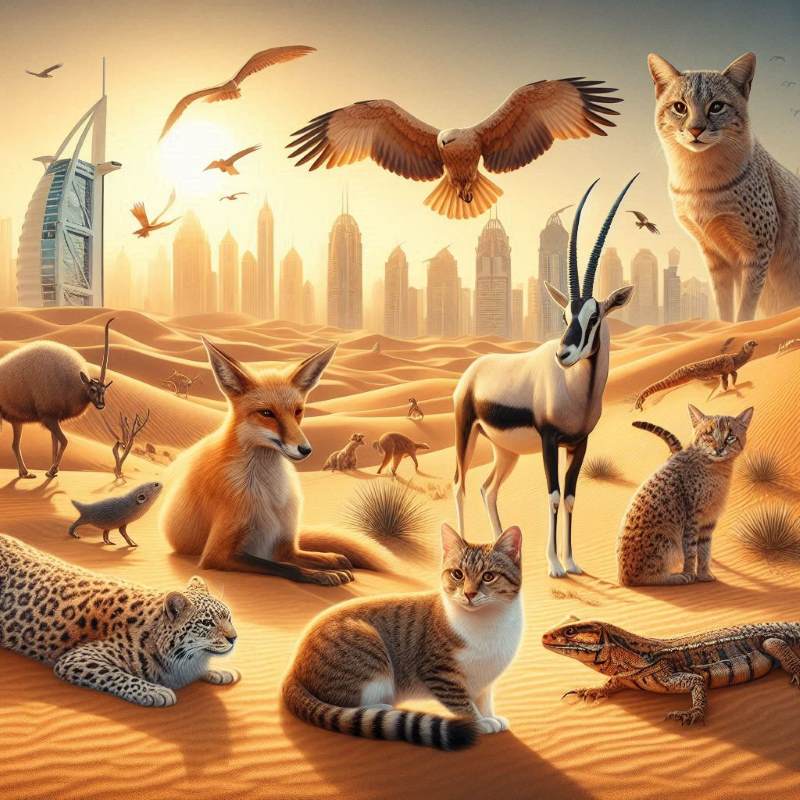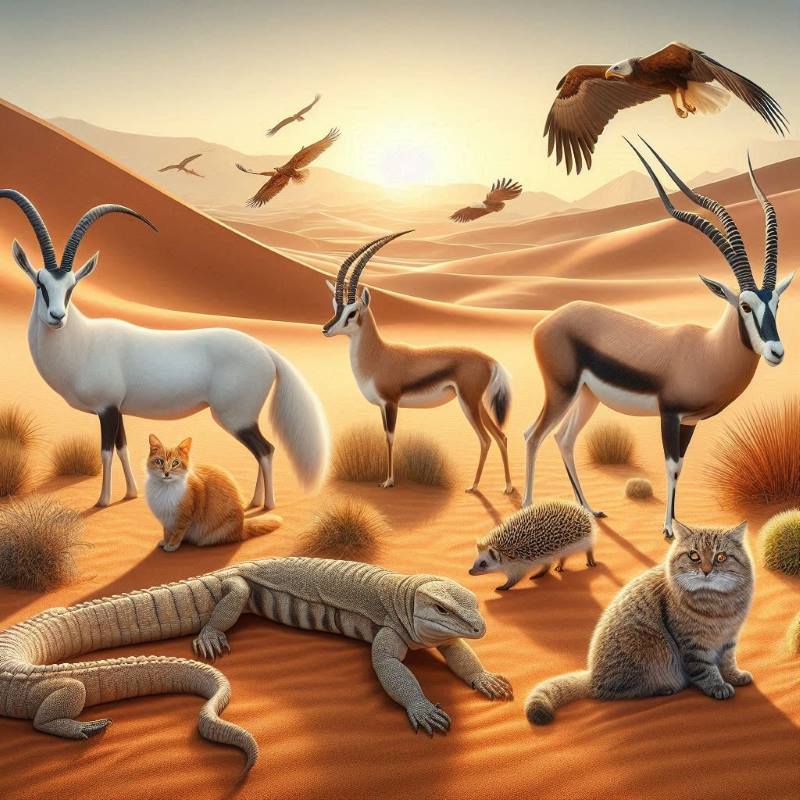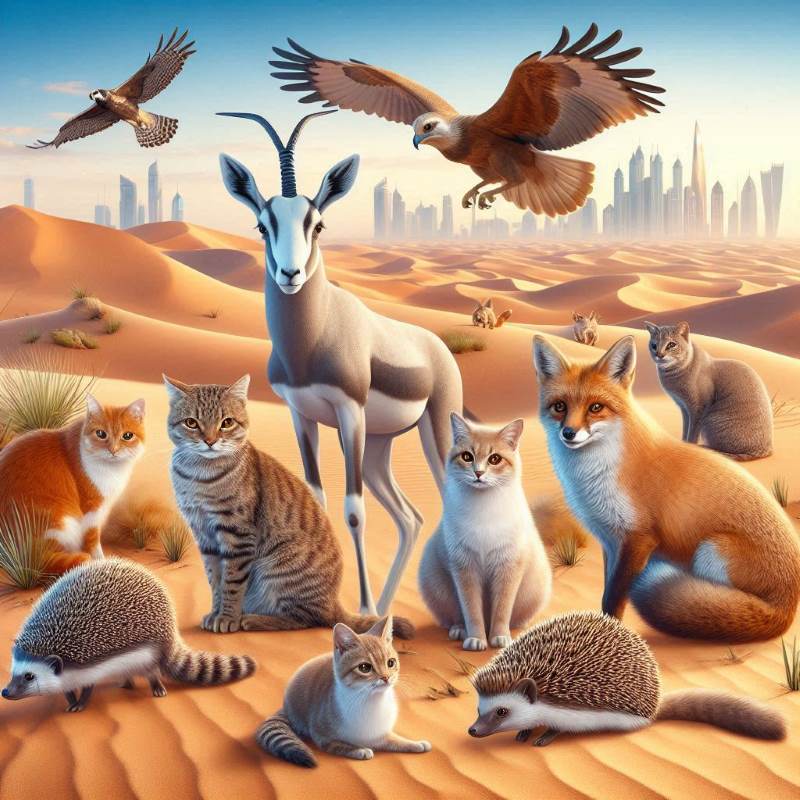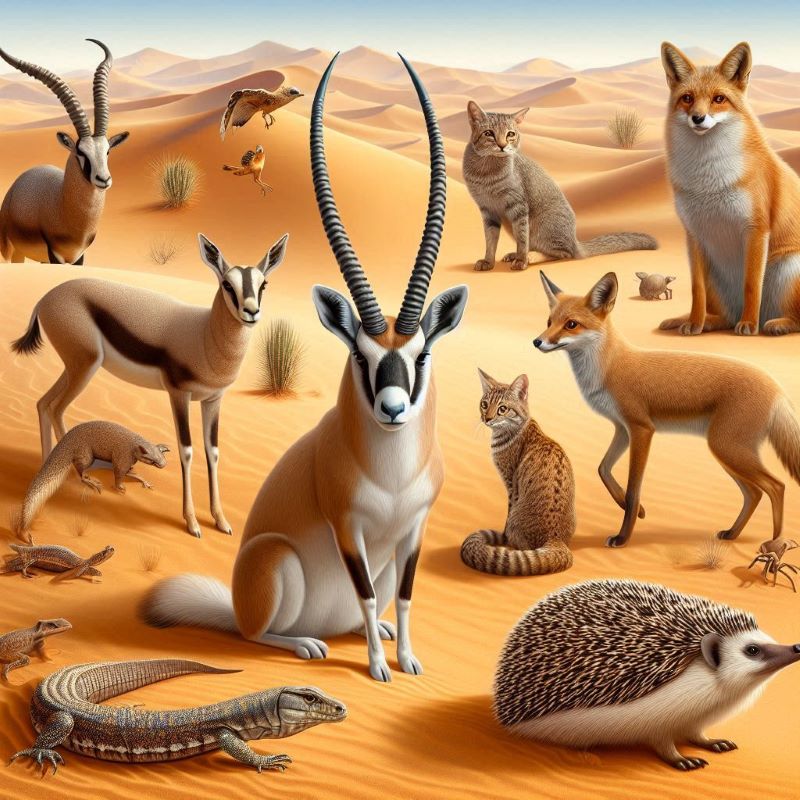Discover the Fascinating Wildlife of the Dubai Desert
The Dubai desert, a vast expanse of golden dunes and arid landscapes, is much more than meets the eye. It’s an intricate and vibrant ecosystem teeming with life, where unique and fascinating wildlife has evolved to thrive under the harshest conditions. Exploring the native animals of this desert not only provides insight into the remarkable adaptations and resilience of these creatures but also offers an unforgettable experience of nature’s wonders. This article will delve into the lives of these extraordinary animals, their habitats, behaviors, and the challenges they face. Additionally, we’ll highlight how Island Tour Safari offers the perfect opportunity to witness these magnificent creatures up close and personal.
Arabian Oryx (Oryx leucoryx)
Appearance and Physical Characteristics: The Arabian oryx is one of the most iconic residents of the Dubai desert. Standing at about 1 meter (3.3 feet) at the shoulder and weighing between 65 to 75 kilograms (143 to 165 pounds), this antelope is easily recognizable by its striking white coat, which reflects the sun’s rays, helping it stay cool in the scorching desert heat. The oryx has long, straight horns reaching up to 75 centimeters (30 inches). These horns are formidable weapons against predators and play a role in thermoregulation.
Habitat and Distribution: Historically, the Arabian oryx roamed across the Arabian Peninsula. Today, after extensive conservation efforts, they are primarily found in protected areas within the UAE, including the Dubai Desert Conservation Reserve. Their preferred habitats are arid and semi-arid regions with sand and gravel plains interspersed with sparse vegetation.
Behavior and Social Structure: Arabian oryxes are social animals, typically forming herds of 10 to 20 individuals, though larger groups have been observed. These herds are usually led by a dominant male, with a clear hierarchy established through displays of dominance and ritualized fighting. The oryx’s social structure plays a crucial role in its survival, offering protection and increasing the foraging efficiency.
Diet and Feeding Habits: The Arabian oryx is primarily a grazer, feeding on various grasses, herbs, and leaves. It has adapted to survive in an environment with scarce water resources, obtaining most of its hydration from the plants it consumes. It is capable of going for long periods without direct water intake, relying on the moisture content in its food.
Conservation Status: Once on the brink of extinction, the Arabian oryx has made a remarkable comeback thanks to concerted conservation efforts. Reintroduction programs and protected reserves have significantly bolstered their numbers, but continued vigilance is necessary to ensure their survival. Their current status is listed as vulnerable by the IUCN.
Experience with Island Tour Safari: Witnessing the Arabian oryx in its natural habitat is a highlight of our desert safari tours. Our knowledgeable guides will share insights into the oryx’s behavior, social structures, and the ongoing conservation efforts to protect this magnificent species.

Sand Gazelle (Gazella subgutturosa marica)
Appearance and Physical Characteristics: The sand gazelle, also known as the Rhim gazelle, is a slender and graceful antelope. Males can weigh up to 29 kilograms (64 pounds) and have slightly curved horns that can reach up to 35 centimeters (14 inches) in length. Females are generally smaller and have shorter, more delicate horns. The gazelle’s coat is pale fawn, blending seamlessly with the sandy desert environment.
Habitat and Distribution: Sand gazelles are adapted to the arid and semi-arid regions of the Arabian Peninsula. They prefer open desert plains, dunes, and stony areas with sparse vegetation. Their range has significantly reduced due to habitat loss and hunting, but they still inhabit protected areas such as the Dubai Desert Conservation Reserve.
Behavior and Social Structure: These gazelles are social creatures, typically forming small groups of up to 10 individuals. During the breeding season, males become territorial and engage in displays of dominance to attract females. Outside of the breeding season, sand gazelles are more nomadic, often moving in response to the availability of food and water.
Diet and Feeding Habits: Sand gazelles are herbivorous, feeding on grasses, leaves, and desert shrubs. They are well adapted to their arid environment and can extract sufficient moisture from their food to survive without drinking water for extended periods.
Conservation Status: The sand gazelle is currently listed as vulnerable by the IUCN. Conservation efforts, including habitat protection and regulated hunting, are crucial to their survival.
Experience with Island Tour Safari: Our safari tours offer a unique opportunity to observe the graceful sand gazelle in its natural habitat. Our guides provide detailed information about their behavior, diet, and challenges in the wild.

Arabian Red Fox (Vulpes vulpes arabica)
Appearance and Physical Characteristics: The Arabian red fox is a smaller, desert-adapted subspecies of the red fox. It has a reddish-brown coat, a lighter underbelly, and a bushy tail tipped with white. Adults typically weigh between 2.2 to 3.6 kilograms (4.9 to 7.9 pounds) and have large ears that help dissipate heat and detect prey.
Habitat and Distribution: Arabian red foxes are highly adaptable and can be found in various habitats, including deserts, semi-arid regions, and even near human settlements. They prefer areas with sufficient cover, such as rocky outcrops and vegetated dunes, where they can find shelter and hunt.
Behavior and Social Structure: These foxes are primarily nocturnal, avoiding the daytime heat by hunting and foraging at night. They are solitary hunters but may form family groups during the breeding season. Arabian red foxes are highly territorial, marking their range with scent to deter intruders.
Diet and Feeding Habits: The Arabian red fox is an opportunistic feeder with a varied diet that includes small mammals, birds, insects, and fruits. Its ability to adapt its diet to the availability of food sources is a key factor in its survival in the harsh desert environment.
Conservation Status: While not currently listed as threatened, the Arabian red fox faces habitat loss and human-wildlife conflict challenges. Conservation efforts focus on habitat protection and reducing human impact on their populations.
Experience with Island Tour Safari: Observing the elusive Arabian red fox is a highlight for many safari guests. Our night safaris provide the best chance to see these nocturnal hunters in action, offering a rare glimpse into their secretive lives.
Sand Cat (Felis margarita)
Appearance and Physical Characteristics: The sand cat is a true desert specialist, with adaptations that allow it to thrive in arid environments. It has a pale, sand-colored coat that provides excellent camouflage, and its large ears are equipped to detect the faintest sounds of prey. Adult sand cats weigh between 1.5 to 3.4 kilograms (3.3 to 7.5 pounds).
Habitat and Distribution: Sand cats inhabit sandy and stony deserts, often far from water sources. They are found in the Arabian Peninsula and parts of North Africa and Central Asia. Their preference for remote and harsh environments makes them one of the most elusive desert dwellers.
Behavior and Social Structure: Sand cats are solitary and nocturnal, hunting small rodents, birds, and insects during the night. They dig burrows to escape the extreme temperatures of the desert and are known for their ability to survive without free-standing water, obtaining moisture from their prey.
Diet and Feeding Habits: As carnivores, sand cats primarily hunt small mammals, but their diet also includes birds, reptiles, and insects. Their hunting strategy relies on stealth and surprise, using their keen senses to locate and capture prey.
Conservation Status: The sand cat is listed as near threatened by the IUCN, and habitat loss and human activity pose significant threats to its populations. Conservation efforts focus on habitat preservation and raising awareness about its plight.
Experience with Island Tour Safari: Spotting a sand cat in the wild is a rare and thrilling experience. Our expert guides know the best times and locations to increase your chances of encountering this elusive feline, making your safari unforgettable.

Spiny-tailed Lizard (Uromastyx leptin)
Appearance and Physical Characteristics: The spiny-tailed lizard, or hub, is a distinctive reptile with a stout body and a spiny tail used for defense. These lizards can grow up to 75 centimeters (30 inches) in length and have a robust build suited to their desert habitat. Their coloration ranges from yellowish-brown to gray, providing camouflage in their rocky surroundings.
Habitat and Distribution: Spiny-tailed lizards prefer rocky and gravelly deserts where they can bask in the sun and hide in caves to escape the heat. They are found across the Arabian Peninsula, including the Dubai desert.
Behavior and Social Structure: These lizards are diurnal, basking in the sun and foraging for food most of their day. They are highly territorial and use their spiny tails to ward off predators and rivals. Spiny-tailed lizards are also known for their social behavior, often seen basking in groups.
Diet and Feeding Habits: Spiny-tailed lizards are primarily herbivorous and feed on leaves, flowers, and fruits. Their strong jaws can crush rigid plant material, allowing them to thrive in their arid environment.
Conservation Status: While not currently listed as threatened, spiny-tailed lizards face threats from habitat destruction and the pet trade. Conservation efforts focus on habitat protection and regulating trade practices.
Experience with Island Tour Safari: Our desert safaris offer the chance to observe spiny-tailed lizards in their natural habitat. Our guides will share fascinating facts about their behavior, diet, and role in the desert ecosystem.
Desert Monitor (Varanus griseus)
Appearance and Physical Characteristics: The desert monitor is a giant lizard known for its impressive size and robust build. Adults can reach lengths of up to 1.5 meters (5 feet) and weigh as much as 3.5 kilograms (7.7 pounds). They have a robust body, strong limbs, and a long, muscular tail that aids swimming and defense.
Habitat and Distribution: Desert monitors are found in arid and semi-arid regions with sparse vegetation. They prefer areas with sandy or rocky substrates where they can dig burrows. Their range includes the Arabian Peninsula, North Africa, and Central Asia.
Behavior and Social Structure: These lizards are primarily solitary and are known for their territorial behavior. They are active during the day, hunting and foraging for food. Desert monitors are excellent diggers, creating extensive burrow systems where they seek refuge from the heat and predators.
Diet and Feeding Habits: Desert monitors are carnivorous and have a varied diet that includes small mammals, birds, reptiles, and insects. They are also known to scavenge, feeding on carrion when available. Their powerful jaws and sharp teeth enable them to tackle a wide range of prey.
Conservation Status: The desert monitor is not currently listed as threatened, but like many desert species, it faces challenges from habitat destruction and human encroachment. Conservation efforts focus on habitat protection and raising awareness about the species.
Experience with Island Tour Safari: A highlight of our safari tours is encountering a desert monitor in the wild. Our knowledgeable guides will provide insights into their behavior, diet, and the critical role they play in the desert ecosystem.
Discovering More Desert Dwellers
The Dubai desert is home to diverse wildlife beyond the well-known species mentioned above. Exploring further, we encounter various smaller but equally fascinating creatures, each with unique adaptations to desert life.

Arabian Hare (Lepus capensis arabicus)
Appearance and Physical Characteristics: The Arabian hare is a subspecies of the Cape hare. It is distinguished by its longer ears and legs, which aid in dissipating heat and increasing speed. The hare has a light brown coat with a white underbelly, blending into the desert landscape.
Habitat and Distribution: Arabian hares are found in arid and semi-arid regions across the Arabian Peninsula. They prefer areas with sparse vegetation where they can forage and find cover from predators.
Behavior and Social Structure: These hares are primarily nocturnal, feeding at night to avoid the daytime heat. They are solitary and rely on their speed and agility to evade predators. During the day, they rest in shallow depressions called forms, which provide some protection from the sun.
Diet and Feeding Habits: Arabian hares are herbivorous, feeding on grasses, herbs, and shrubs. They have a high metabolic rate and require a moisture-rich diet to stay hydrated.
Conservation Status: The Arabian hare is not currently listed as threatened, but its habitat loss and hunting affect its populations. Conservation efforts focus on habitat protection and regulating hunting practices.
Experience with Island Tour Safari: Spotting an Arabian hare in the wild requires keen observation and a bit of luck. Our guides will help you track these elusive creatures, providing insights into their behavior and challenges in the desert environment.
Golden Eagle (Aquila chrysaetos)
Appearance and Physical Characteristics: The golden eagle is one of the world’s giant birds of prey, with a wingspan of up to 2.3 meters (7.5 feet). It has dark brown plumage with a golden sheen on its head and neck, from which it gets its name. These eagles have powerful talons and a sharp beak designed for hunting.
Habitat and Distribution: Golden eagles are found in various habitats, including deserts, mountains, and open plains. In the Dubai desert, they are often seen soaring high above, scanning the ground for prey.
Behavior and Social Structure: Golden eagles are solitary hunters known for their keen eyesight and powerful flight. They hunt various prey, including mammals, birds, and reptiles. These eagles are monogamous and often form long-term pair bonds, with both parents participating in raising their young.
Diet and Feeding Habits: The golden eagle’s diet varies, depending on prey availability. They primarily hunt small to medium-sized mammals but are also known to take birds and reptiles. Golden eagles are potent predators, capable of taking down prey much more significant than themselves.
Conservation Status: The golden eagle is not currently listed as threatened, but its populations are affected by habitat loss, poisoning, and human disturbance. Conservation efforts focus on protecting nesting sites and reducing human impact on their habitats.
Experience with Island Tour Safari: A golden eagle in the wild is a majestic sight. Our safari tours offer the chance to see these magnificent birds in their natural habitat, with our guides providing detailed information about their behavior and conservation.

Desert Hedgehog (Paraechinus aethiopicus)
Appearance and Physical Characteristics: The desert hedgehog is a small, nocturnal mammal with a distinctive coat of spines. It weighs between 280 and 510 grams (10 to 18 ounces) and has a light brown or grayish body with a paler underside. Its spines protect from predators.
Habitat and Distribution: Desert hedgehogs are found in arid and semi-arid regions, including deserts and rocky areas. They prefer habitats with sparse vegetation and ample cover to forage and hide from predators.
Behavior and Social Structure: These hedgehogs are solitary and nocturnal, foraging at night for insects, small mammals, and plants. During the day, they rest in caves or under rocks to escape the heat. When threatened, they curl into a tight ball, using their spines as a defense mechanism.
Diet and Feeding Habits: Desert hedgehogs are omnivorous, eating insects, small vertebrates, and plant material. Their varied diet helps them survive in the harsh desert environment, where food sources can be scarce.
Conservation Status: The desert hedgehog is not currently listed as threatened, but its populations are affected by habitat loss and predation by introduced species. Conservation efforts focus on habitat protection and controlling invasive species.
Experience with Island Tour Safari: Spotting a desert hedgehog in the wild is a rare treat. Our night safaris offer the best chance to see these nocturnal creatures in action, with our guides providing fascinating insights into their behavior and ecology.
The Importance of Conservation and Sustainable Tourism
The survival of these remarkable desert animals depends on ongoing conservation efforts and sustainable tourism practices. Habitat destruction, climate change, and human-wildlife conflict pose significant threats to the delicate balance of the desert ecosystem. By choosing eco-friendly and responsible tour operators like Island Tour Safari, you can help support these efforts and preserve this unique environment.
Why Choose Island Tour Safari?
At Island Tour Safari, we are committed to providing an unforgettable experience while promoting the conservation of the Dubai desert’s unique wildlife. Our expert guides are passionate about the desert and its inhabitants, offering in-depth knowledge and insights that enhance your safari experience. By joining our tours, you get to witness the beauty and resilience of the desert’s wildlife and support efforts to protect and preserve their habitats for future generations.
Book Your Dubai Desert Safari Today
Embark on a journey of discovery with Island Tour Safari and explore the incredible wildlife of the Dubai desert. Whether you’re a nature enthusiast, a photographer, or simply seeking a unique adventure, our safari tours promise an experience like no other. Book your tour today and immerse yourself in the wonders of the desert.



No comment yet, add your voice below!